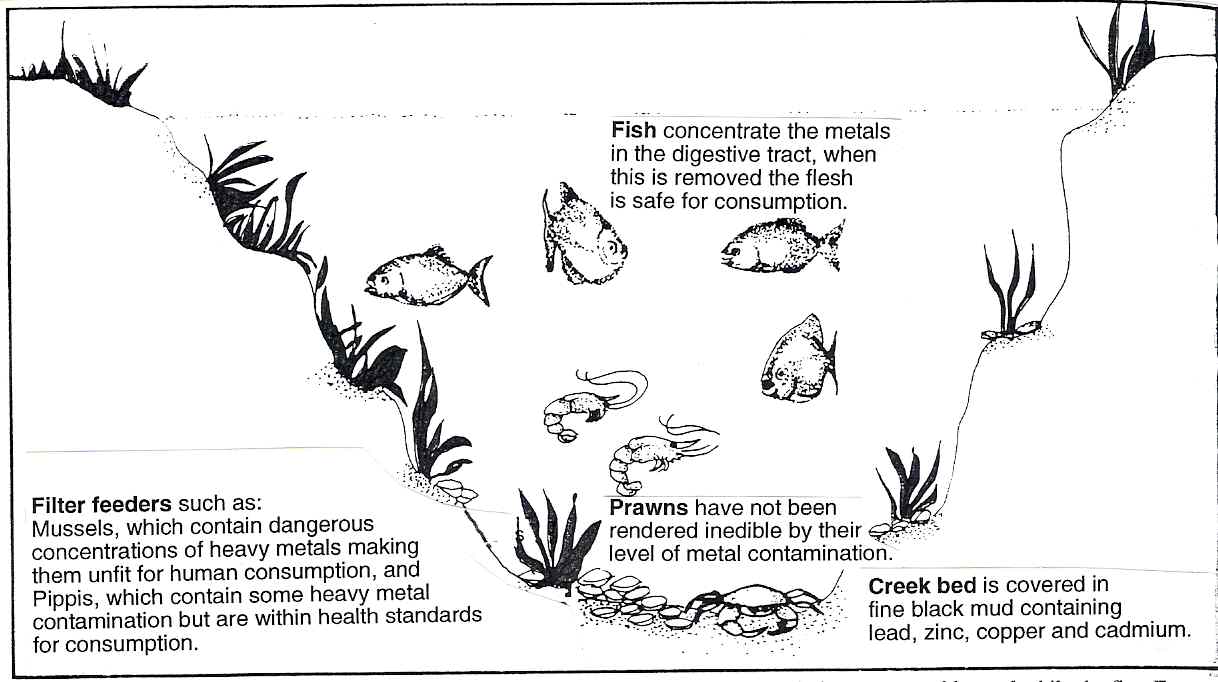 |
|||
|
LEAD Action News Vol 2 no 2 Autumn 1994
ISSN 1324-6011 |
|||
|
About Us
|
Lead and Other Heavy Metals Heavy Metal Speciation in Waters, Sediments and Biota from Lake Macquarie, NSW Extracts from a 1987 paper by G.E. Batley Division of Energy Chemistry, CSIRO, Lucas Heights Abstract The distribution and bioavailability of heavy metals in waters and sediments from Lake Macquarie (NSW) have been examined. Elevated concentrations of zinc, lead, cadmium and copper detected in surface sediments and waters from the northern end of the lake are attributable to discharges from a lead-zinc smelter on Cockle Creek. The majority of the metals are in bioavailable forms and are shown to be accumulated in seagrasses, seaweeds and bivalves... Bivalve molluscs Samples of the hairy mussel Trichomya hirsuta (5-6 em length) and the cockle Anadara trapezia (8-9 cm length) were collected from Fennels Bay, at the northern end of the lake. No live samples were found during sampling of the sediments at southern lake sites. The soft flesh of these samples was freeze-dried, homogenized and determined by neutron activation analysis, for a range of elements, to identify other elements in addition to lead and zinc which might have been concentrated in these species as a result of inputs to the lake. For Trichomya, average values of 70 µg (micrograms) Zn (zinc) g-¹ (per gram), 0.99 µg Pb (lead) g-¹, 4.9 µg Cd (cadmium) g-¹, 2.6 µg Cu (copper) g-¹, 7.9 µg As (arsenic) g.1 and 33 µg Se (selenium) g-¹ were found on freeze dried, whole-body flesh samples. For Anadara, the corresponding values were 84 µg Zn g-¹, 1.2 µg Pb g-¹, 12.9 µg Cd g-¹, 1.7 µg Cu g-¹, 12.0 µg As g-¹ and 6.4 µg Se g-¹. Gold and cobalt were also detected but at less significant concentrations. Furner (1979) has previously reported a comprehensive study of copper, lead, cadmium and zinc in these species from Lake Macquarie. At comparable sites, his measured concentrations, especially for lead (9.3 µg g-¹ and 9.2 µg g-¹ respectively for Trichomya and Anadara), were significantly higher in both species than those found in this study. Cadmium was also higher in Furner's Trichomya samples. The high cadmium concentrations found in Anadara were confirmed by our data, and similar levels are found in samples analysed by the NSW Department of Agriculture (private communication). Harris et al (1979) noted that Anadara bioconcentrated cadmium to a greater extent than did oysters or mussels. Samples from Westernport Bay in Victoria typically contained 4 µg Cd g-¹, 1 µg Pb g-¹, 45 µg Zn g-¹ and 800 µg Fe g-¹. Only cadmium and zinc levels differed from our data. It would appear that cadmium concentration may limit the suitability of this species for human consumption.
Don't cat the cockles in Cockle Creek. Shellfish such as pippis and hairy mussels are commonly known as cockles and while the first Europeans in the area named the creek after the abundance of edible cockles. today the hairy mussel is dangerously polluted by lead. copper, zinc and cadmium. The effects of this heavy metal pollution on other forms of marine life arc summarised in the diagram above. Reprinted from "Australia: Environments and People" (p.242) by Margaret Martin and Garry Allenby with kind permission of the publisher, Science Press. |
||
|
About
Us |
bell
system lead poisoning |
Contact Us
| Council
LEAD Project | egroups | Library
- Fact Sheets | Home
Page | Media Releases Newsletters | Q & A | Referral lists | Reports | Site Map | Slide Shows - Films | Subscription | Useful Links | Search this Site |
|||
| Privacy Policy | Disclaimer | |||
|
Last
Updated 05 November 2012
Copyright © The LEAD Group Inc. 1991- 2012 PO Box 161 Summer Hill NSW 2130 Australia Phone: +61 2 9716 0014 |
|||
